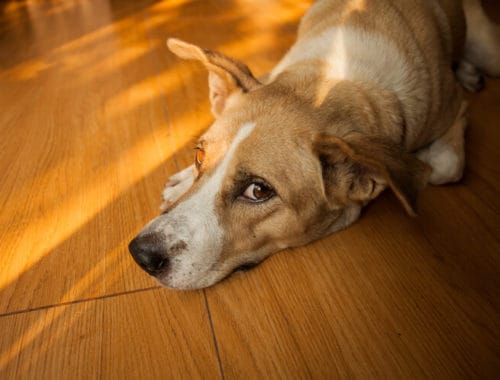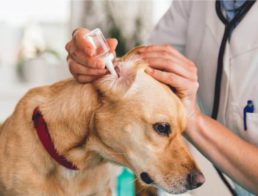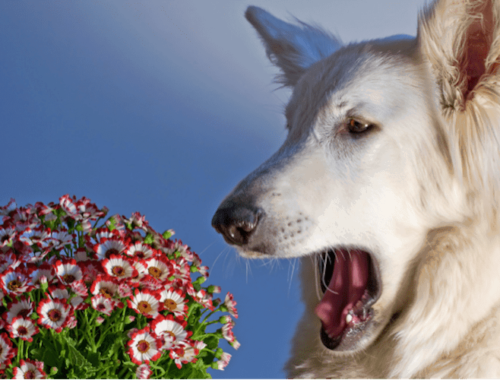“I swear this just started a few hours ago. He was fine yesterday! What happened?”
The nice lady was clearly worried about her beautiful Golden Retriever, Boomer. He sat in front of me, panting and trying to rub a sore on the side of his neck about the size of a small dinner plate. The sore was sticky and red. I noticed Boomer had small scabs and pink spots on his belly, too.
“Boomer has skin allergies,” I told his surprised owner.
She shook her head in disbelief. “I can’t believe this could happen so fast! He’s three years old and has never had any problems. What can I give my dog for allergies?”
What Causes Skin Allergies in Dogs?
Atopy is the medical term for allergy and is defined by Merriam Webster’s dictionary as:
“A genetic disposition to develop an allergic reaction (such as allergic rhinitis or asthma) and produce elevated levels of IgE upon exposure to an environmental antigen and especially one inhaled or ingested.”
Dogs with atopy are more likely to show skin symptoms than respiratory symptoms like humans. Atopic dermatitis is the term veterinarians use for skin allergy symptoms in dogs. It’s similar to eczema in humans.
The simple explanation of atopic dermatitis is that your dog’s immune system misidentifies normal substances as foreign invaders. When your pup breaths in plant pollen, his immune system reacts as if the body is under attack. The immune reaction leads to the symptoms we see in dogs with atopic dermatitis.
Typical Canine Allergy Symptoms
The most common skin allergy symptoms in dogs are:
- Pruritus (itchy skin)–licking, scratching, rubbing, etc.
- Pink or red skin
- Hair loss
- Bumps, scabs and sores on the skin
- Red, weepy or mucous-filled eyes
- Ear inflammation
Areas of the body that are most affected are around the eyes, mouth, lower chest, belly, legs, ears and around the anus.
Dogs start showing symptoms of atopy when they’re around 1 to 3 years of age. Symptoms tend to be worse in certain seasons, especially spring and autumn.

How to Treat Dog Allergies
Veterinary Medications
For dogs with severe allergy symptoms, veterinarian-prescribed medications can bring quick relief. The older medications contain corticosteroids (most people just call them steroids) like prednisone. These drugs suppress the overactive immune system just enough to bring relief.
Steroids work well but can cause side effects like increased thirst, urination, appetite and panting. Long-term use of steroids can cause serious health problems and is best avoided.
Newer medications also work to turn off certain overactive immune responses but without the side effects of a steroid. Two medications that have proven effective in treating atopic dermatitis are a pill called Apoquel (oclacitinib) and an injection called Cytopoint (Canine Atopic Dermatitis Immunotherapeutic). Ask your vet for more information.
Over the Counter Medications and Home Remedies
Dogs with mild allergy symptoms (mild to moderate scratching but no sores) may respond well to home treatment with over the counter medications. These are generally safe for healthy adult dogs but ask your veterinarian first if your dog has other health issues or is less than one year old.
- Strict control of fleas. Use veterinarian prescribed flea preventives for your dog and treat your home with Flea Busters powder.
- Antihistamines. There are several to try. You can start with one and if it doesn’t help after a week, move to the next one. Here’s a good list of antihistamines with recommended dosages for dogs: antihistamines for dogs.
- Medicated shampoos, conditioners, and sprays. Oatmeal, pramoxine, and hydrocortisone can bring short-term relief to itchy dogs. Plan on bathing your dog 1 to 3 times a week during allergy flare-ups.
- Omega-3 Fatty Acid Supplements. Use as directed on the label. It can take up to 6 weeks to see the full effects of the supplement.
Other Tips for Dogs with Allergies
- Thorough and consistent house cleaning. Dogs can be allergic to dust (pollen) and dust mites. Vacuum frequently with a good vacuum cleaner, wash bedding weekly, and minimize the use of carpet and cloth furnishings.
- Keep windows closed during your dog’s allergy season. This will decrease pollen entering the house where your dog spends a lot of time.
- Use a good air purifier with HEPA technology.
- Minimize your dog’s contact with grass, especially while it’s being mowed. Grass allergies are common, but grass also collects pollen from other plants.
- Rinse your pet after walking him outdoors. Even if you’re not bathing him daily, a good rinse can remove irritating pollens from his feet and coat.
- Avoid walking your dog before 10:30 a.m. when pollen levels tend to be high. Also, avoid walking him outdoors on windy days as pollen levels increase as the wind jostles blooming plants.

























